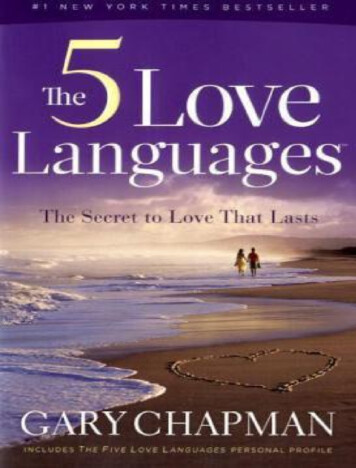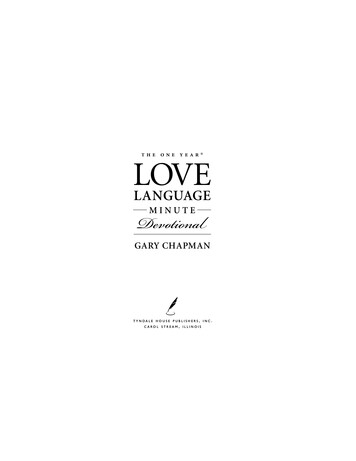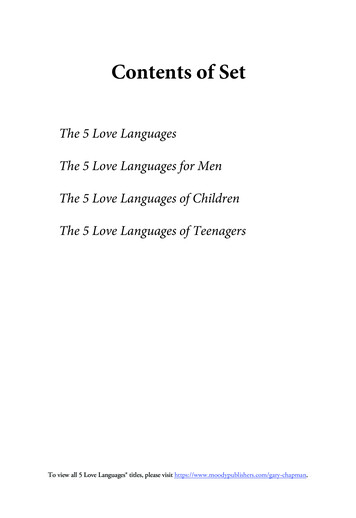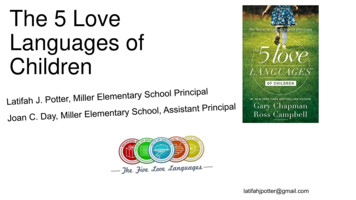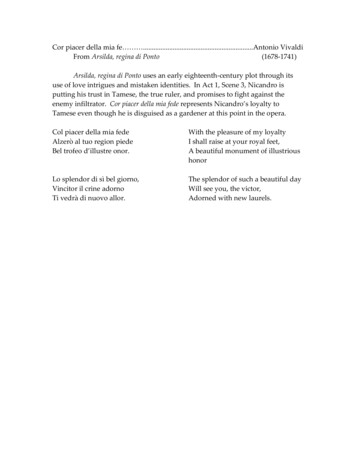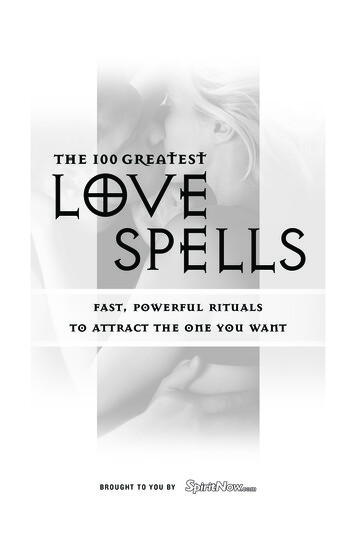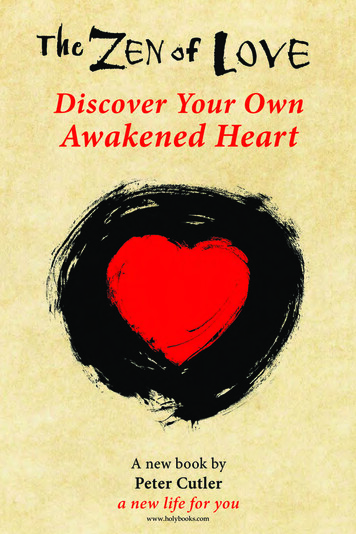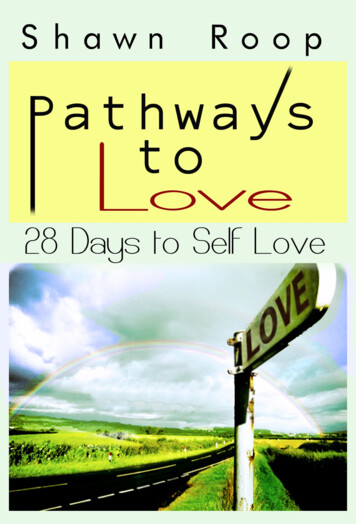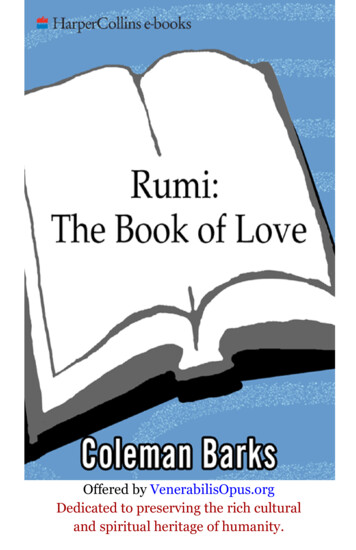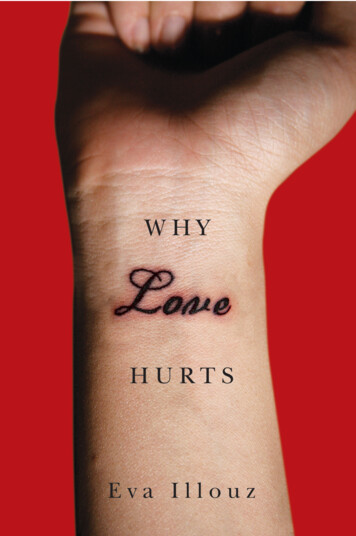
Transcription
Why Love Hurts
Why Love HurtsA SociologicalExplanationEva Illouzpolity
Copyright Eva Illouz 2012The right of Eva Illouz to be identified as Author of this Work has beenasserted in accordance with the UK Copyright, Designs and Patents Act 1988.First published in 2012 by Polity PressPolity Press65 Bridge StreetCambridge CB2 1UR, UKPolity Press350 Main StreetMalden, MA 02148, USAAll rights reserved. Except for the quotation of short passages for the purpose ofcriticism and review, no part of this publication may be reproduced, stored in aretrieval system, or transmitted, in any form or by any means, electronic, mechanical,photocopying, recording or otherwise, without the prior permission of the publisher.ISBN-13: 978-0-7456-6152-0A catalogue record for this book is available from the British Library.Typeset in 10.5 on 12 pt Sabonby Toppan Best-set Premedia LimitedPrinted and bound in Great Britain by MPG Books Group Limited, Bodmin, CornwallThe publisher has used its best endeavours to ensure that the URLs for external websitesreferred to in this book are correct and active at the time of going to press. However,the publisher has no responsibility for the websites and can make no guarantee that asite will remain live or that the content is or will remain appropriate.Every effort has been made to trace all copyright holders, but if any have beeninadvertently overlooked the publisher will be pleased to include any necessary credits inany subsequent reprint or edition.For further information on Polity, visit our website: www.politybooks.com
ContentsAcknowledgmentsvii1Introduction: The Misery of Love2The Great Transformation of Loveor the Emergence of Marriage Markets18Commitment Phobia and the New Architectureof Romantic Choice (with Mattan Shachak)59341The Demand for Recognition: Loveand the Vulnerability of the Self1095Love, Reason, Irony1566From Romantic Fantasy to Disappointment1987Epilogue238Notes249Index282
AcknowledgmentsIn more than one way, I started writing this book in my head manyyears ago, while still an adolescent. It is the product of hundreds,perhaps thousands, of conversations with close friends and strangersthat left me perplexed and puzzled by the chaos that pervades contemporary romantic and sexual relationships. Why is it that despitetheir strength and autonomy, women in the four countries in whichI have lived during my adult life (France, the United States, Israel,and Germany) are baffled by the elusiveness of men? Why do menseem to have become a puzzle and an ongoing source of bemusementfor women? And did the men and women of the past agonize aboutlove in the same way as modern men and women do? Most of thesurrounding culture instructs us to answer these questions by lookingfor the hidden history of our flawed childhood and to explain thedisarray of romantic lives with flawed psyches. This book wants toquestion this largely unquestioned assumption. It wants to explainwhy love hurts by highlighting the social, rather than the psychological, context of men’s and women’s encounters.This book, then, emerges from the intimacy of many hours ofconversation, but it owes much to other, less intimate but no lessimportant, conversations. My first thanks go to the Wissenshaftskolleg zu Berlin, which during the 2007–8 year provided the peaceand quiet of a monastery and the intense conversations of an eighteenth-century salon. I thank Dale Bauer, Ute Frevert, Sven Hillerkamp,Axel Honneth, Tom Laqueur, Reinhart Merkel, Reinhart MeyerKalkus, Susan Neiman, John Thompson, and Eitan Wilf for engagingme so compellingly in their thoughts, questions, and often brilliant
viiiAcknowledgmentssuggestions. Mattan Shachak has been entirely necessary to theprocess of writing this book; he has made tangible on a daily basisthe joy of being the teacher of an outstanding student and researchassistant. Ori Schwarz, Dana Kaplan, and Zsuza Berend have readmany chapters; their comments have been crucial in helping me significantly improve the book. I thank them for their remarkable intellectual generosity. Nathalie-Myriam Illouz, my sister and a brilliantpsychoanalyst, and Beatrice Smedley, my friend and fellow-writer,have endlessly discussed with me the splendor and misery of love. Ican only hope to emulate the subtlety of their analyses.A book is a special kind of commodity: it must be not only produced by expert heads and hands, but also believed in. Polity Pressis unique in its dedication to furthering the global circulation of ideas,and in its intimate, intense care in the process of producing a book.I am privileged to have seen this book endorsed so wholeheartedlyby John Thompson. The depth of his care and the precision of hisresponsiveness make him an exceptional publisher. Justin Dyer hasbeen a superb editor, and Jennifer Jahn and Clare Ansell have beenmost responsive and helpful as editorial assistant and productioneditor, respectively.I thank all the people, close friends and strangers, who confidedin me and told me their stories, sometimes in despair, often in hopeand trust. I dedicate this book to the men and the women I will keeploving for a long time, painlessly and painfully.The publishers would like to acknowledge the following for permission to reproduce the epigraphs:From INDIGNATION by Philip Roth. Copyright (c) 2008, PhilipRoth, used by permission of The Wylie Agency (UK) Limited;Chris Carter, www.catchhimandkeephim.com;From DISGRACE by J.M. Coetzee, copyright (c) 1999 by J. M.Coetzee. Used by permission of Viking Penguin, a division of PenguinGroup (USA) Inc. and of Vintage, a division of Random House;From LOVE, ETC. by Julian Barnes, copyright (c) 2000 by JulianBarnes. Used by permission of Alfred A. Knopf, a division of RandomHouse, Inc.; published by Vintage Books. Reprinted by permission ofThe Random House Group Ltd;
I want my works to be read by the far-from-frigid virginOn fire for her sweetheart, by the boy,In love for the very first time. May some fellow-suffererPerusing my anatomy of a desire,See his own passion reflected there, cry in amazement:Who told this scribbler about my private affairs?Ovid, Amores
1IntroductionThe Misery of LoveBut Bliss in love is seldom the case: For every successful contemporarylove experience, for every short period of enrichment, there are tendestructive love experiences, post-love “downs” of much longer duration – often resulting in the destruction of the individual, or at leastan emotional cynicism that makes it difficult or impossible ever to loveagain. Why should this be so, if it is not actually inherent in the loveprocess itself?Shulamith Firestone, The Dialectic of Sex: The Case forFeminist Revolution1Wuthering Heights (1847) belongs to a long literary tradition portraying love as an agonizingly painful emotion.2 The novel’s notorious protagonists, Heathcliff and Catherine, develop a strong love foreach other while growing up together, yet Catherine decides to marryEdgar Linton, a socially more appropriate match. Humiliated whenhe accidentally overhears Catherine claim that she would degradeherself in marrying him, Heathcliff runs away. Catherine looks forhim in the fields, and when she does not find him, she falls ill to thepoint of near-death.In a far more ironic mode, Madame Bovary (1856) describes theunhappy marriage of a romantic woman with a kind-hearted butmediocre provincial doctor, who cannot satisfy his wife’s sappilyromantic and social fantasies. Its eponymous protagonist thinks shehas found the hero she has so frequently read and dreamed about inthe figure of Rodolphe Boulanger, a dashing landowner. After a threeyear-long affair, they decide to elope. On the fateful day, Emmareceives Rodolphe’s letter breaking off his promise. Here the narrator
2Introduction: The Misery of Lovedispenses with his usual irony when describing the romantic feelingsof his heroine, instead describing her suffering with compassion:She leant against the embrasure of the window, and reread the letterwith angry sneers. But the more she fixed her attention upon it, themore confused were her ideas. She saw him again, heard him, encircledhim with her arms, and throbs of her heart, that beat against her breastlike blows of a sledge-hammer, grew faster and faster, with unevenintervals. She looked about her with the wish that the earth mightcrumble into pieces. Why not end it all? What restrained her? She wasfree. She advanced, looking at the paving-stones, saying to herself,“Come! come!”3By our own standards, Catherine and Emma’s pain seems extreme,but it is still intelligible to us. Yet, as this book seeks to claim, theromantic agony that both of these women experience has changed itscontent, color, and texture. First of all, the opposition between societyand love which each enacts in her suffering is hardly relevant tomodern societies. Indeed, there would be few economic obstacles ornormative prohibitions preventing either Catherine or Emma frommaking their love their first and only choice. If anything, our contemporary sense of appropriateness would command us to follow thedictates of our heart, not of our social milieu. Second, a battery ofexperts would now be likely to come to the rescue of a hesitantCatherine and of Emma’s passionless marriage: psychological counseling, couple therapy, divorce lawyers, mediation specialists, wouldmassively appropriate and adjudicate over the private dilemmas ofprospective or bored wives. In the absence of (or in conjunction with)experts’ help, their modern counterparts would have shared the secretof their love with others, most likely female friends, or, at the veryleast, occasional anonymous friends found on the Internet, thus considerably diminishing the solitude of their passion. Between theirdesire and their despair, there would have been a thick flow of words,self-analysis, and friendly or expert advice. A contemporary Catherineor Emma would have spent a great deal of time reflecting and talkingabout their pain and likely found its causes in their own (or theirlovers’) deficient childhood. They would have derived a sense of glorynot from the experience of grief, but precisely from having overcomeit, through an arsenal of self-help therapeutic techniques. Modernromantic pain generates an almost endless gloss, the purpose of whichis both to understand and extirpate its causes. Dying, committingsuicide, and running away to a cloister no longer belong to ourcultural repertoires. This is not to say, obviously, that we, “post-” or
Introduction: The Misery of Love3“late” moderns, do not know something about the agony of love. Infact we may possibly know more about it than our predecessors. Butwhat it does suggest is that the social organization of romantic painhas changed profoundly. This book is about understanding the natureof that transformation through an examination of the changes undergone in three different and crucial aspects of the self: the will (howwe want something), recognition (what matters for our sense ofworth), and desire (what we long for and how we long for it).In fact, few people living in the contemporary era have been sparedthe agonies of intimate relationships. These agonies come in manyshapes: kissing too many frogs on the way to Prince/ss Charming;engaging in sisyphean Internet searches; coming back lonely frombars, parties, or blind dates. When relationships do get formed,agonies do not fade away, as one may feel bored, anxious, or angryin them; have painful arguments and conflicts; or, finally, go throughthe confusion, self-doubts, and depression of break-ups or divorces.These are only some of the ways in which the search for love is anagonizingly difficult experience from which few modern men andwomen have been spared. If the sociologist could hear the voices ofmen and women searching for love, s/he would hear a long and loudlitany of moans and groans.Despite the widespread and almost collective character of theseexperiences, our culture insists they are the result of faulty or insufficiently mature psyches. Countless self-help manuals and workshopsprofess to help us better manage our romantic lives by making usmore aware of the ways in which we unconsciously engineer our owndefeats. The Freudian culture in which we are steeped has made theforceful claim that sexual attraction is best explained by our pastexperiences, and that the love preference is formed in early life in therelationship between the child and its parents. For many, the Freudianassertion that the family designs the pattern of the erotic career hasbeen the main explanation for why and how we fail to find or tosustain love. Undaunted by incoherence, Freudian culture even furtherclaims that whether our partner is opposite or similar to our parents,s/he is a direct reflection of our childhood experiences – themselvesthe key to explaining our romantic destiny. With the idea of repetitioncompulsion, Freud went one step further and argued that early experiences of loss, however painful, will be reenacted throughout adultlife, as a way to gain mastery over them. This idea had a tremendousimpact on the collective view and treatment of romantic misery, suggesting it is a salutary dimension of the process of maturation. More:Freudian culture suggested that, by and large, romantic misery wasinevitable and self-inflicted.
4Introduction: The Misery of LoveClinical psychology has played a uniquely central role in suggesting (and bestowing scientific legitimacy on) the idea that love and itsfailures must be explained by the psychic history of the individual,and that, as a result, they are within the purview of her/his control.Although the original Freudian notion of the unconscious aimedat dissolving traditional authorial notions of responsibility, in practice, psychology played a crucial role in relegating the realm of theromantic and the erotic to the individual’s private responsibility.Whether psychoanalysis and psychotherapy
free. She advanced, looking at the paving-stones, saying to herself, “Come! come!”3 By our own standards, Catherine and Emma’s pain seems extreme, but it is still intelligible to us. Yet, as this book seeks to claim, the romantic agony that both of these women experience has changed its content, color, and texture. First of all, the opposition between society
